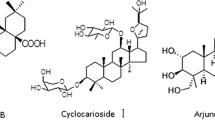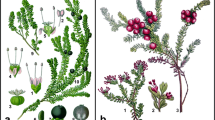Abstract
Oleoresin extracted from copaiba (Copaifera spp.: Leguminosae) trees is a popular traditional medicine in Amazonia. I studied production ecology from three copaiba types in the eastern Brazilian Amazon. Mean oleoresin yield from the first harvest was 0.07 liters per tree for all trees drilled and 0.23 liters per tree for ones yielding some oleoresin. Yields were comparable toC. multijuga results in central Amazonia but lower than anecdotal reports of 2 liters or more per tree. Yield differences were minor between tree types and seasons. Yield peaked in mid-size trees (45-65 cm DBH) while small (45 cm DBH), very large (>65 cm DBH), and hollow trees (due to senescence or fire) yielded negligible amounts. Oleoresin was harvested almost exclusively from inner heartwood, indicating that factors stimulating its synthesis in cambium are probably distinct from factors that promote its storage in heartwood and loss of yield many years later.
Similar content being viewed by others
Literature Cited
Alencar, J. C. 1982. Estudos silviculturais de uma população natural deCopaifera multijuga Hayne (Leguminosae) na Amazônia Central. 2. Produção de óleo-resina. Acta Amazonica 12(1):75–89.
—. 1988. Estudos silviculturais de uma população natural deCopaifera multijuga Hayne (Leguminosae) na Amazonia Central IV. Interpretação de dados fenologicos em relação a elementos climãticos. Acta Amazonica 18(3–4): 109–209.
Ankarfjard, R., andM. Kegl. 1998. Tapping oleoresin fromDipterocarpus alatus (Dipterocarpaceae) in a Lao village. Economic Botany 52(1):7–14.
Arrhenius, S., andJ. Langenheim. 1983. Inhibitory effects ofHymenaea and Copaifera leaf resins on the leaf fungusPestalotia subcuticularis. Biochemical Systematics and Ecology 11:361–366.
Bergström, B., G. Gustafsson, R. Gref, andA. Ericsson. 1999. Seasonal changes of pinosylvin distribution in the sapwood/heartwood boundary ofPinus sylvestris. Trees 14:65–71.
Cascon, V., andB. Gilbert. 2000. Characterization of the chemical composition of oleoresins ofCopaifera guianensis Desf.,Copaifera duckei Dwyer andCopaifera multijuga Hayne. Phytochemistry 55: 773–778.
Desmarchelier, C., J. Coussio, andG. Ciccia. 1997. Extracts of Bolivian plants,Copaifera reticulata andHeisteria pallida inhibit in vitro free radicalmediated DNA damage. Phytotherapy Research 11(6):460–462.
Duke, J. A., andJ. L. Cellier. 1993. CRC Handbook of Alternative Cash Crops. CRC Press, Boca Raton, FL.
Dwyer, J.D. 1951. The Central American, West Indian and South American species ofCopaifera (Caesalpiniaceae). Brittonia 7(3): 143–172.
Fearnside, P.M. 1992. Forest biomass in Brazilian Amazônia: comments on the estimate by Brown and Lugo. Interciencia 17(1): 19–27.
Ferreira, L.A., andE. M. Braz. 2001. Avaliação do potencial de extração commercial do óleo-resina de copaíba. The New York Botanical Garden, New York and UFAC, Rio Branco, Brazil. http://www.nybg.org/bsci/acre/evaluation.html.
Greenberg, C. H., andR. W. Simons. 1999. Age, composition, and stand structure of old-growth oak sites in the Florida High Pine Landscape: implications for ecosystem management and restoration. Natural Areas Journal 19(l):30–40.
Hillis, W.E. 1987. Heartwood and tree exudates. Springer-Verlag, Berlin.
Langenheim, J. H. 1973. Leguminous resin-producing trees in Africa and South America. Pages 89–104 in B. J. Meggers, E. S. Ayensu, and W. D. Duckworth, eds., Tropical forest ecosystems in Africa and South America: a comparative review. Smithsonian Institution Press, Washington, DC.
—. 2003. Plant resins: chemistry, evolution, ecology, and ethnobotany. Timber Press, Portland, OR.
Le Cointe, P. 1947. Arvores e plantas uteis. Companhia Editora Nacional, São Paulo.
Leite, A., A. Alechandre, C. Rigamonte-Azevedo, C. A. Campos, andA. Oliveira. 2001. Recomendacoes para o manejo sustentável do óleo de copaíba. Universidade Federal do Acre and Secretaria Executiva de Floresta e Extrativismo (SEFE), Rio Branco.
Lindenmayer, D. B., R. B. Cunningham, M. L. Pope, P. Gibbons, andC. F. Donnelly. 2000. Cavity sizes and types in Australian eucalypts from wet and dry forest types—a simple rule of thumb for estimating size and number of cavities. Forest Ecology and Management 137:139–150.
Macedo, C.A., andJ. H. Langenheim. 1989. Intraand inter-plant sesquiterpene variability in Copaifera langsdorfii: relation to microlepidopteran herbivory. Biochemical Systematics and Ecology 17(7–8):551–557.
Mattheck, C., K. Bethge, andP. W. West. 1994. Breakage of hollow tree stems. Trees Structure and Function 9:47–50.
MMA/SCA (Ministerio do Meio Ambiente, Secretaria de Coordenac,ao da Amazonia), GTA—Grupo de Trabalho Amazonica and SEBRAE—Servic.0 Brasileira de Apoio as Micro e Empresas. 1998. Copaíba. Produtos Potenciais da Amazonia. MMA, SCA, SUFRAMA, SEBRAE, Brasília.
Orallo, C.A., andV. P. Veracion. 1984. Comparison of four methods of tapping Benguet pine (Pinus kesiya Royle ex Gordon) for oleoresin production in Benguet. Sylvatrop Philippines Forest Research Journal 9(l–2):55–64.
Osol, A., andG. E. Farrar, eds. 1947. The dispensatory of the United States of America, 24th Edition. J.B. Lippincott Co., Philadelphia.
Phillips, M.A. andR.B. Croteau. 1999. Resin-based defenses in conifers. Trends in Plant Science 4(5): 184–191.
Plowden, C. 2001. The ecology, management and marketing of non-timber forest products in the Alto Rio Guamá indigenous reserve (eastern Brazilian Amazon). Ph.D. dissertation, Penn State University, University Park.
Ramirez, N., andM.K. Arroyo. 1990. Estructura poblacional deCopaifera pubiflora Benth. (Leguminosae; Caesalpiniodeae) en los altos llanos centrales de Venezuela. Biotropica 22(2): 124–132.
Sales, N.P.D. 1994. Os Tembé no Alto Rio Guamá: reelaborações étnicas—identidade e território. UNAMA —Universidade da Amazonia, Belém.
Spruce, R. 1970. Notes of a botanist on the Amazon and Andes. Vol. 1. Johnson Reprint Corp., New York.
Veiga, V. F., {jrJr.}, andA. C. Pinto. 2002. O gêneroCopaifera L. Quimica Nova 25(2):273–286.
Vetter, R.E., andP. C. Botosso. 1989. Remarks on age and growth rate determination of Amazonian trees. IAWA Bulletin 10(2): 133–145.
Author information
Authors and Affiliations
Rights and permissions
About this article
Cite this article
Plowden, C. Production ecology of CopaÍba (Copaifera spp.) oleoresin in the eastern brazilian Amazon. Econ Bot 57, 491–501 (2003). https://doi.org/10.1663/0013-0001(2003)057[0491:PEOCCS]2.0.CO;2
Received:
Accepted:
Issue Date:
DOI: https://doi.org/10.1663/0013-0001(2003)057[0491:PEOCCS]2.0.CO;2




